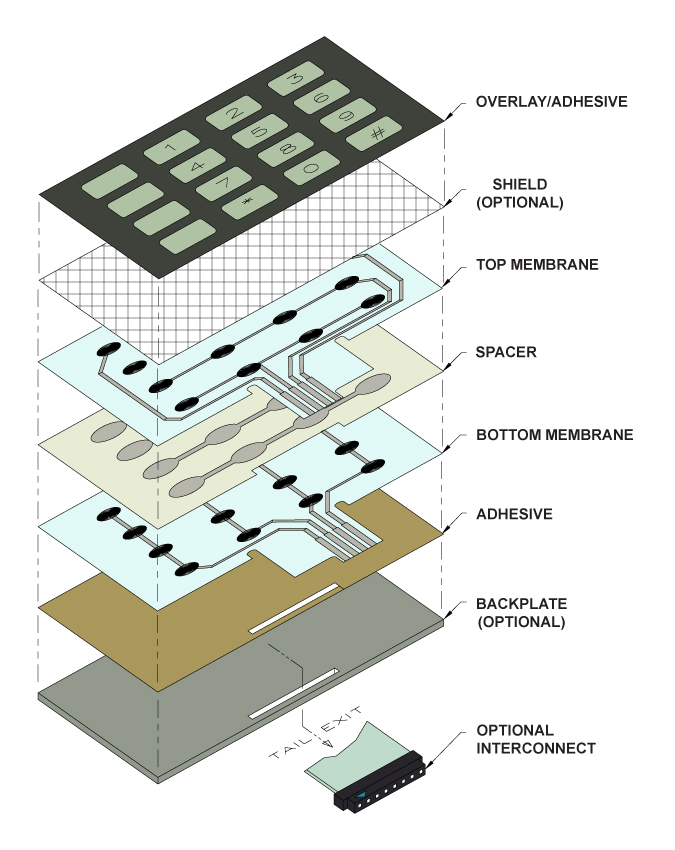The Complete Guide to Membrane Switch Technology and Its Applications
How Membrane Layer Switches Over Contribute to the Toughness of Electronic Control Panels
Membrane layer buttons play a crucial role in boosting the toughness of electronic control panels, mostly with their multi-layered building and construction which gives reliable defense versus ecological factors such as moisture and dirt. The absence of moving parts considerably minimizes the probability of mechanical failures, making membrane layer changes perfect for demanding applications.
Meaning of Membrane Buttons

Membrane layer switches are made to be slim and light-weight, making them ideal for applications where room is restricted. They can be manufactured in various shapes, dimensions, and shades, supplying flexibility in style that fulfills aesthetic and practical requirements. Additionally, membrane switches can integrate different modern technologies, such as responsive comments and LED indicators, enhancing user experience.
Due to their construction, membrane buttons are commonly immune to dirt, wetness, and general wear, adding to their sturdiness in requiring environments. Their smooth design not just facilitates easy cleansing but also reduces the danger of mechanical failure, making them a favored selection for suppliers looking for trustworthy interface in their digital control board.
Defense Against Environmental Aspects
The design of membrane switches over inherently supplies a degree of security against numerous ecological aspects, which is important for keeping functionality in tough problems - Membrane Switch. These switches are typically built with layers of adaptable products that shield inner elements from dampness, dust, and pollutants. By enveloping the wiring, membrane changes lessen the danger of short circuits and deterioration, which can significantly hinder efficiency
Furthermore, the usage of durable adhesives and sealants during production improves their resistance to environmental challenges. Membrane layer switches can endure direct exposure to chemicals and solvents, making them appropriate for markets such as food handling and health care, where health and cleanliness are paramount. Their seamless surface style additionally protects against the build-up of dust and microorganisms, promoting easier cleansing and upkeep.
Temperature level changes are one more ecological issue, and membrane layer switches are crafted to operate properly across a large range of temperatures (Membrane Switch). This flexibility guarantees that control panels stay operational in various setups, from commercial atmospheres to customer electronic devices
Influence On Individual Communication
Individual interaction with digital control panels is substantially affected by the layout and capability of membrane layer buttons. These buttons provide a responsive user interface that improves the total customer experience, permitting intuitive navigation and control. Their responsive nature makes sure that individuals get instant feedback upon activation, which is crucial for jobs calling for precision and efficiency.
In addition, the smooth surface area of membrane switches facilitates very easy cleaning and maintenance, promoting customer self-confidence in the dependability of the user interface. This cleanliness is specifically important in atmospheres where health is extremely important, such as medical or food handling setups. In addition, the portable and lightweight style of membrane changes adds to the aesthetic appeal of control you can look here panels, encouraging user engagement with a modern-day and streamlined look.
Moreover, the assimilation of aesthetic aspects, such as printed icons and backlighting, helps individuals promptly recognize functions, decreasing the discovering curve linked with new devices. As an outcome, users can run devices extra properly, bring about enhanced efficiency and satisfaction. In summary, membrane buttons play a crucial function in boosting individual interaction by integrating functionality, looks, and convenience of usage, eventually causing boosted operational performance.
Layout Versatility and Modification
Style versatility and modification are necessary aspects of membrane layer buttons, enabling producers to customize electronic control board to particular applications and customer demands. This adaptability permits for the combination of different layout aspects, such as colors, graphics, and structures, which can enhance the visual allure and customer involvement of the control panel.
Membrane layer buttons can be personalized in dimension and shape, suiting a wide variety of devices and applications, from industrial machinery to consumer electronics. This adaptability ensures that makers can develop user-friendly user interfaces that align with individual assumptions and operational demands. Additionally, the capacity to integrate one-of-a-kind functions such as backlighting or tactile responses better boosts use, permitting for a more interactive experience.
Furthermore, the manufacturing process for membrane layer switches over supports the quick prototyping of designs, enabling producers to iterate and fine-tune their principles swiftly. This capacity not just increases the growth timeline however likewise ensures that the final item satisfies details practical and visual standards.

Cost-Effectiveness and Longevity
Cost-effectiveness and durability are news considerable advantages of membrane switches, making them an attractive choice for producers and end-users alike. These switches are normally less pricey check here to produce than typical mechanical switches, mostly due to their streamlined production procedures and the decreased number of parts needed. This cost benefit expands not only to initial manufacturing however also to lasting operational expenses, as membrane layer switches often require much less maintenance and have a reduced failure price.
Additionally, the durability of membrane switches over adds to their total value. Constructed from long lasting materials, they are immune to environmental variables such as wetness, dirt, and chemicals, which can bring about premature wear in various other switch kinds. The lack of moving parts minimizes mechanical failing, allowing membrane layer switches to keep performance over expanded periods.
This sturdiness is particularly valuable in applications needing consistent efficiency under demanding problems, such as medical tools and industrial tools. Eventually, the mix of cost-effectiveness and durability makes membrane layer switches a financially viable selection for manufacturers, giving trusted remedies that endure the test of time while maximizing monetary considerations.
Conclusion
In verdict, membrane layer switches dramatically enhance the durability of digital control panels with their durable building and construction and protective features - Membrane Switch. Overall, membrane switches over stand for a trusted and cost-efficient selection for enhancing the durability and functionality of digital control systems.